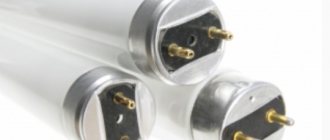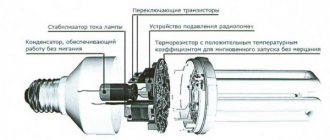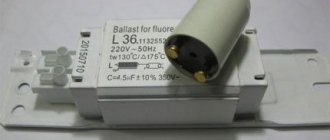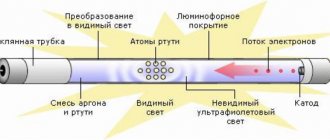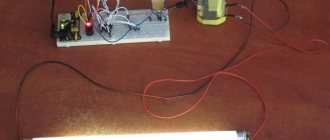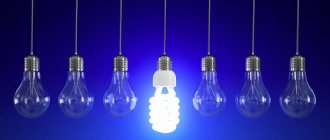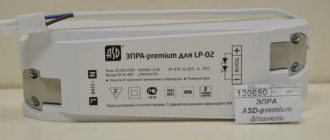Fluorescent lamps were invented a long time ago. Initially, the companies that made them followed virtually no standards. This was primarily due to the simplicity of the design of such lamps. Manufacturers' freedom of choice regarding the size and configuration of such lighting equipment was not limited in any way. However, in the end, the process of assembling such lamps did become more manageable. The list of types of fluorescent lamps supplied to the market today is wide, but still limited. Such equipment is classified according to various criteria displayed in the labeling. For fluorescent lamps it is usually applied directly to the bulb.
What types are there
All fluorescent lamps supplied to the market today may differ in the following ways:
- spectrum of light;
- flask diameter;
- power;
- number of socles and their characteristics;
- the presence or absence of starting equipment;
- mains voltage;
- flask shape.
Such lamps can also be classified according to the color of the glow and light temperature.
Of course, a consumer who decides to purchase a luminescent model must first of all be informed about all its technical characteristics. The latter are displayed, like any other equipment, in this case in the markings. For fluorescent lamps it looks something like this:
- LB T8 w8 FS G13 RS 220 V. 2U.
In some cases, the order of numbers may change. Also, in some cases, only part of the characteristics are displayed in the lamp code.
Exotic
In general, the non-standard form of fluorescent lamps dates back to the times of neon advertising. Now that the manufacturer has a lot of opportunities to make a tube of any configuration, shaped lamps have mainly begun to be used for bold design solutions. Such products are not marked with familiar symbols. In order to find out their technical characteristics, you need to look at the product passport.
Such fluorescent lamps fit very well into futuristic interiors. Interestingly, this type of lamp and the light it spreads cannot be achieved using any other type of lighting source.
Differences in flask diameter and length
This parameter for fluorescent lamps can vary within fairly wide limits. Many of its other technical characteristics directly depend on the diameter of the flask of such equipment:
- range;
- luminosity;
- life time.
It is believed that the thicker the fluorescent lamp, the longer it can last.
The diameter in the marking of such equipment, according to international standards, is indicated by numbers following the letter T. Its unit is 1/8 inch. For example, the diameter of a flask marked T8 will be 26 mm. Such lamps are currently very common. Also, equipment of this type with flask diameters of 18 and 38 mm is very popular on the market.
Sometimes the dimensions of lamps in the markings can be given simply as numbers. For example, such equipment may have the designation 26/604. In this case, the first number will indicate the diameter, and the second will indicate the length of the flask in millimeters.
Flaws
Among the disadvantages of fluorescent lamps are:
- Increased cost of products;
- Harmful effects on human well-being during prolonged use of artificial lighting. In addition, such housekeepers are harmful to the eyes;
- The service life is noticeably reduced when the light is turned on/off frequently;
- They fail due to voltage surges (it is necessary to additionally install an overvoltage protection device);
- Light intensity cannot be adjusted using a dimmer;
- Do not use in dusty or damp areas (for example, when installing electrical wiring in a bathhouse);
- They do not work well at low temperatures;
- If the flask is broken, mercury can negatively affect the human body;
- They require specialized disposal, which may not be available in every city.
As you can see, these products have more disadvantages than advantages. However, when used correctly, all the shortcomings immediately “fly away”, leaving only the main advantage - high energy-saving properties.
What can be the power
This parameter is indicated in the marking by the letter W and the numbers following it. Knowing the power of a fluorescent lamp, you can determine how large a room it can illuminate. For example, this indicator can be coded as 11 W, 15 W, 20 W.
With regard to power, the designations in the marking of fluorescent lamps correspond to certain codes of the same equipment with an incandescent filament. These ratios are indicated in special tables. The data presented in them can greatly facilitate the buyer’s choice. For example, the designation 11 W will correspond to an incandescent lamp power of 55 W, 15 W - 75 W, 20 W - 100 W.
Some information to make your choice easier
Naturally, the power of the lamp determines its durability, as well as the strength of the luminous flux, including after some time of operation. Knowing these parameters of fluorescent lamps, you can choose the optimal lighting device that will not spoil the mood during installation.
For example, with a power consumption of such a lighting device of 30 watts, the average service life will be 15,000 hours. The average luminous flux after 100 hours of burning for white (LB) will be equal to 140 lm, warm and cold white - 100 lm. For daytime it is 180 lm, and for daytime color this figure will be 80 lm. But the parameters of the LDC will be different.
Unusual fluorescent lamp
Do not forget that starterless lamps, although they consume no less electricity than lamps with a starter, still have a slightly longer lifespan. Therefore, the best option would be to purchase just such fluorescent lamps and then exclude starters from their circuit. This is not difficult to do, and such work will not take much time.
Decoding the markings of fluorescent lamps: characteristics of the bases
The design of the lamp may include 1 or 2 such elements. In the first case, the marking will contain the designation FS, in the second - FD. Sometimes you can see the FB code on fluorescent lamps. This is how compact equipment with a built-in electronic ballast type base is marked.
The characteristics of this part of the design of fluorescent lamps are indicated by a letter and two numbers. The sockets can be marked, for example, as:
- G - pin.
- E - threaded.
The numbers following the letter in the marking indicate the outer diameter.
Principle of operation
The operating principle of such a device is as follows:
- At the beginning, both electrodes included in the design are in the open position.
- When connected to the mains, a glow discharge occurs inside the device, the strength of which varies between 20 and 50 mA.
- The resulting discharge acts on the bimetallic electrode and causes its gradual heating.
- The heated material causes the actuator electrode to bend. Because of this, the glow discharge disappears, which then helps to close the circuit.
- The current begins to move in a closed circuit, which helps heat the inductor and cathodes of the fluorescent lamp.
- Due to the disappearance of the glow discharge, the bimetallic electrode begins to gradually cool after a certain period of time. As a result of these changes, the electrodes move apart, which leads to an open circuit.
- This action helps generate a fast high voltage pulse that acts on the inductor.
- The choke has a high degree of inductance, so this process contributes to the ignition of the lamp.
- The illumination of the lamp gradually increases, and it begins to consume more voltage from the power source.
- The starter is connected in parallel with the lamp, so the starter begins to lack energy and therefore can generate a new glow discharge. Therefore, the electrodes then remain open.
You may be interested in this Rules for the placement of lamps on a suspended ceiling
Operating principle of LDS
Launch equipment
Modern industry today produces two main types of fluorescent lamps:
- in addition to which it is necessary to purchase a starter;
- with the possibility of inclusion in a circuit with ballast, without starting equipment;
- universal.
The first type of equipment is marked as Phs, the second - RS, the third - US. Sometimes the letters characterizing the method of starting the lamp may not be in the code. This means that the starter for this equipment is a mandatory element.
Classification
By type of base:
- Can be made similar to the base of an incandescent lamp , directly connected to the network of so-called compact fluorescent electric lamps.
- Instead of a threaded surface section , they have pins on both sides of the light source tube for mounting in a special socket by rotating the lamp in the socket.
On the use of electronic ballasts (EPRL):
- Using EPRL , as a rule, a compact type of lamps has a number of advantages, expressed in eliminating the flickering effect, better ignition, no freezing of the lamp, lower noise levels due to the absence of a choke that creates it, lighter weight and having greater energy efficiency;
- Illumination sources that do not use EPRL are, as a rule, tubular type.
By design:
tubular
- Having a tubular design , made in the form of a straight tube and the same shape of the base, they are marked with the letter T, followed by an indication of its diameter in eighths of an inch;
- Compact , can be manufactured with the ability to be installed in a socket for a regular incandescent lamp, containing a built-in ballast that softens the voltage drop during startup.
By presence of starter:
- Starter (UB) , in which the initial start during operation is ensured by the presence of a starter connected to the circuit parallel to the lighting source by a connection.
- Starterless (AB) in which a short-term increase in voltage in the network when starting a lighting source occurs due to the passage of current through special windings of the choke coil, and are characterized by a greater loss of power (35%) than the starter counterpart (25%).
By power:
- Low power (up to 15 W).
- High power (over 80 W).
By type of discharge occurring:
- Arc.
- Glow discharge.
- Smoldering glow.
By type of light distribution:
- With no direction of light emission.
- With directional light emission, reflective, slot and panel types.
By outgoing radiation:
- Daylighting.
- Lamps of various colors.
Limited radiation spectrum range:
- UV lamps.
Types of mercury lighting sources used:
- High pressure devices used in street illumination and installations of significant lighting power.
- Low pressure devices used for lighting industrial premises and housing.
Marking of starters for fluorescent lamps
Such starting devices are small gas-discharge lamps with a glowing charge. The following codes can be applied to the starter flask:
- C - starter;
- the numbers in front of it are power (60, 90, 120);
- the numbers after it are the voltage (220, 127).
Also, the marking of starters for fluorescent lamps may be Western. In this case, on the equipment flasks:
- at 220 V with a voltage of 4-80 W, the code S10, FS-U or ST111 is applied;
- at 127 V with a power of up to 20 W - S2, FS-2, ST151.
Voltage
Most fluorescent lamps produced by modern industry are designed for use in a standard household electrical network. That is, most often such equipment operates at a voltage of 220 V.
However, fluorescent lamps of 127 and 75 V are also available for sale today. The first type of such equipment, designed for reduced voltage, is used in the subway. 75 V lamps are usually installed in electric trains.
The markings indicate the voltage required for such equipment directly. That is, exactly 220 V, 127 V or 75 V.
Lamp shape
There are also many types of luminescent equipment for this parameter. In the marking of a lamp, the shape of its bulb can be indicated as:
- U - horseshoe-shaped.
- 4U - four-arc.
- S - spiral.
- C - candle-shaped.
- R - reflex type.
- G - spherical.
- T - in tablet form.
The linear shape of the bulb is not displayed in any way in the lamp markings.
Additional information: color
Quite often, manufacturers in the labeling of fluorescent lamps also display such characteristics as the color of the glow and light temperature.
In this case, the cipher will contain three digits. The first one displays the color rendering index. This indicator should not be confused with the luminosity spectrum. Most often, the color rendering index is determined by the color of the lamp bulb. It indicates the degree of compliance, declared by the manufacturer, with a natural shade. In the color marking of fluorescent lamps, it is indicated as 1x10 Ra. That is, for example, the code 742 (number 7) displays the equipment color rendering index of 70 Ra.
The last two digits in the marking in this case indicate the color temperature of the light emitted by the lamp, measured in Kelvin. In our example, it will be equal to 4200 K. That is, a lamp with this marking will emit cold light.
The numbers indicating the color rendering index and temperature are usually placed at the very end of the code on the lamp. Before their combination there is the word Color.
Codes for lamps of other types
In addition to fluorescent ones, incandescent light bulbs are, of course, very popular among domestic consumers. There is also a wide range of LED models on the market today. In this regard, the consumer may have a question about which markings do not apply to fluorescent lamps.
For example, LED models, in addition to power (W), base type, color indicators and voltage, may contain codes in the code:
- maximum permissible operating temperature (usually from +40 to -40 °C);
- duration of the operating period (usually 50 thousand hours).
The bulb type code for LED lamps differs from the code for fluorescent lamps. In this case, the designation comes after the letter A.
The code for an incandescent light bulb usually contains one or two Cyrillic letters and five numbers. The letters indicate the type of model (V - vacuum, B - double-spiral, Ш - spherical, BO - double-spiral argon with an opal flask, etc.). The first three digits in the marking of such equipment indicate the operating voltage, the last two indicate the power. Sometimes the code of such light bulbs also contains the date of their release.
How miniature devices work
Energy-saving light bulbs, much smaller in size than standard ones, were created thanks to a radical redesign of the design. They learned to curl the luminous tube itself in a spiral, bend it into several folds like an accordion, and make it in a classic round or pear-shaped shape.
Features of the flask structure
It was the ability to give the desired shape that became the main achievement towards the development of compact fluorescent lamps (CFLs). All other minor obstacles were overcome electronically.
The design of such equipment includes three leading components: a glass flask, a ballast and a base.
The inside of the product flask is coated with a phosphor. It converts the ultraviolet rays generated by the device into a luminous flux that will be visible to the human eye.
The performance, lighting color and other lighting technical parameters of the lamp depend on the quality of the composition of this substance.
Tungsten electrodes are mounted in the light bulb, onto the surface of which a mixture of an active complex of chemicals - calcium, barium and strontium - is applied. The space is filled with an inert gas supplemented with about 3-8 mg of mercury
Phosphors used in the production of CFLs are based on rare earth elements. They differ from those used in the manufacturing process of linear fluorescent devices.
Their cost is several tens of times higher, but this is fully justified by the fact that substances of this group are capable of functioning under conditions of high surface irradiation density.
This feature made it possible to significantly reduce the diameter of the discharge tube.
The range of compact lamps includes various shapes: U-shaped with a certain number of tubes, type F, spiral, ring, candles
Types of ballasts
Since fluorescent light sources cannot operate directly from the network, their design provides an auxiliary device for connection - built-in or external control gear.
Electronic ballasts are powered by high-frequency voltage, which increases luminous flux and output, and also reduces the flicker level of lamps. The better and more reliable the mechanism, the longer the light bulb lasts
During the startup period, the electronic component heats the electrodes and then maintains normal current power parameters regardless of surges in the supply voltage.
Lamps with external electromagnetic equipment are called non-integrated. They are equipped with an unusual base, a series-connected choke and starter.
Types of CFL bases
Mini-representatives of fluorescent light bulbs are equipped with one of two types of bases: pin or threaded.
Threaded sockets are marked “E”. This is the most common type of connection, identical to a simple incandescent lamp.
For small luminaires, E14 minions are provided. The E27 socket is suitable for standard household cartridges, and the E40 socket is suitable for more powerful and larger sockets. The thread diameter of products in millimeters is determined by the number indicated in the marking
G sockets connect the light bulb to the socket according to a special circuit through a system of pins - usually there are two or four of them. The most popular among them are G23 and G27. They are mainly screwed into table lamps.
In industrial premises and retail outlets, lamps with a G24 base are common. The G53 base is ideal for installation in plasterboard and suspended ceiling systems.
Osram lamp color designations
The numbers after the word Color in the marking of fluorescent equipment are one of the most important codes for the consumer. For example, popular Osram lamps may have the following color designations:
- 765 (70...79 Ra, 6500 K);
- 865 (80...89 Ra, 6500 K);
- 965 (90...99 Ra, 6500 K);
- 954 (more than 90 Ra, 5400 K), etc.
Colors such as SKYWHITE and INTERNA are patented by this manufacturer. The first of them is designated in the labeling of Osram fluorescent lamps as 880 (80...89, 8000 K), the second - 827 (80...89, 2700 K).
Philips colors
Equipment of this brand also enjoys well-deserved popularity among domestic consumers. Philips fluorescent lamps are labeled as standard. The color rendition of this equipment can be indicated by numbers from 4 to 9. The temperature of lamps of this brand is encrypted by numbers from 27 to 65. Also, the marking of Philips models may contain their series (for example, TL-D).
In addition to the usual ones, this manufacturer also produces luminescent equipment intended for installation in aquariums - TLD AQUARELLE. Such lamps differ from standard ones in that they emit light with a high density in the blue spectrum. This shade not only emphasizes the beauty of the underwater world, but also contributes to:
- creating optimal conditions for photosynthesis;
- stimulating the formation of oxygen in water, which is very beneficial for fish.
The diameter of the bulbs of these lamps can be 16 mm or 28 mm (T5, T9). Also in the TLD AQUARELLE marking there are codes G5 and G13, which characterize the parameters of the bases. The power of these lamps can be 8-58 W.
Popular brands
Tubular fluorescent light sources are often used in shops and industrial premises. White light (LB) and fluorescent light (LD) lamps are popular. According to the European designation, the most used are 765 (cold) and 640 (warm) light (Osram branding). Philips TLD is labeled 54 (cold) and 33 (warm).
| Type LL | Characteristics | Application |
| Linear lamp type T8 (26 mm) | Popular lamps with a power of 36 W and 18 W with G13 base. Service life on average is 10 thousand hours. For starting, ballasts based on an electromagnetic choke or electronic ballasts (electronic ballasts or electronic ballasts) are used. | Power is reflected in length. The larger it is, the longer the lamp. |
| Linear lamp type T5 (16 mm) | Power 6 – 28 W, service life from 6 thousand to 10 thousand hours. An electronic ballast circuit is used for starting. | Lamps are used in living rooms, they are placed in pendant lamps, in the interiors of domestic premises. |
| Linear lamp type T4 (12.5 mm) | Tube diameter 12.5 mm. Power range - from 6 to 24 W. Color temperatures 6400K and 4200K are the most common. Service life is from 6 thousand to 8 thousand hours. Electronic ballast is required for starting. | The lamps are used for illuminating mobile phones, with a G5 base in table lamps. |
